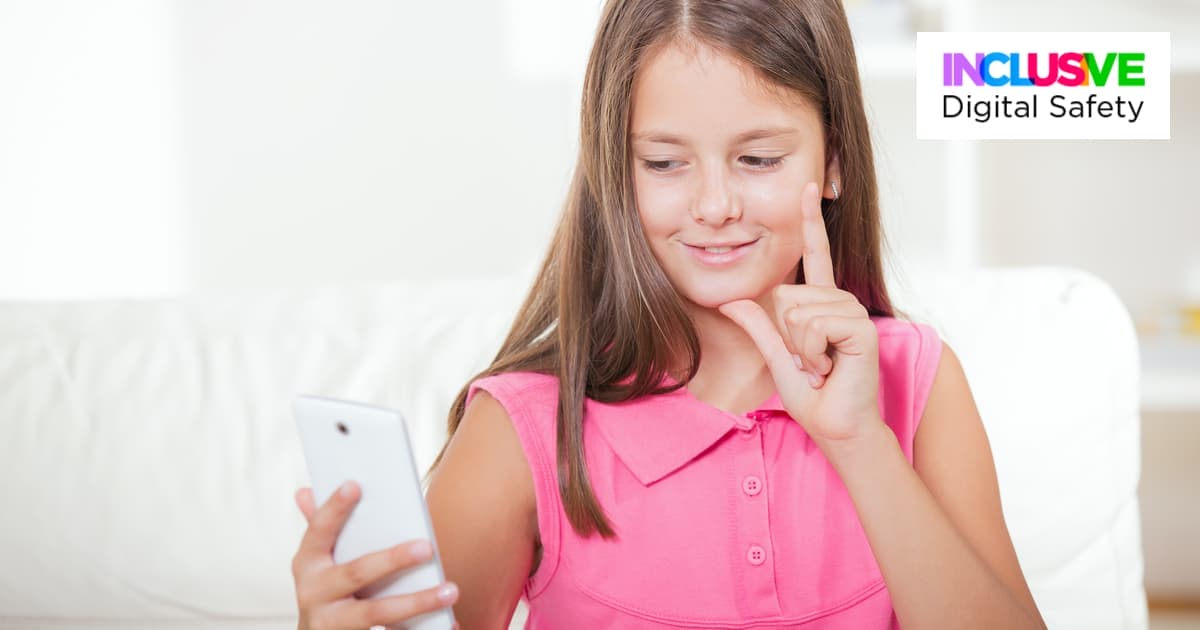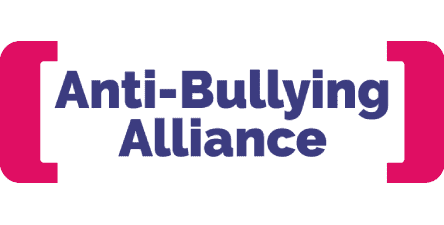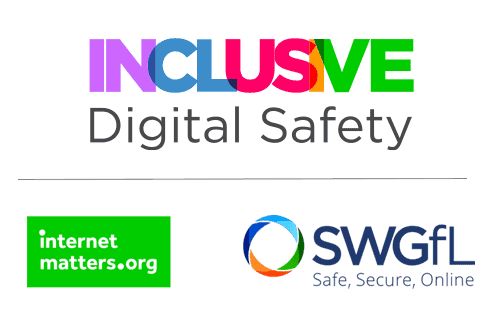
Contacting the National Crime Agency CEOP Command
To help children and young people with Special Educational Needs and Disabilities (SEND) connect and share safely with others online, we’ve provided insight and advice on what you can do as a parent or carer to support them.

Of course CYP with SEND use the internet to connect in just the same way as everyone else – to make and maintain friendships and share experiences. But the benefits may be greater for these young people because:
Friendships can be easier to maintain online especially if not attending a local school.
Online connections can offer an escape from being the child who is always seen as ‘different’ or who has additional needs – they can be themselves.
Connections can also be made in supportive and nurturing environments and provide a place to explore common interests.
Some children may find socialising behind a screen easier than face to face.
From our research, we know that CYP with SEND experience greater risks when it comes to content, contact, or conduct risks.
Any child, from any background, can be at risk of the following risks online. But some are more vulnerable than others:
CYP told us they are aware that risks and harms exist, but less able to take steps to avoid them, either because they simply did not recognise them in their own social feed or did not feel able to act.
This lack of critical thinking was a key issue that will impact their online experience. These young people are more likely than most to accept what people say online and to trust what strangers or friends say, without considering the consequences.
Whilst many CYP do not understand the data implications of their online lives, this may be even more complex for CYP with SEND. They may be confused about privacy settings, and about what they were supposed to protect, as they think they have nothing private on their profiles.
Numbers of followers is often seen as an indication of popularity, which can be even more important for CYP with SEND who are often excluded and made to feel unpopular. This means private settings are even less attractive as it would make it impossible to attract followers.
It’s likely that there will be a greater need for parent/carer and child conversations about online life and who they are connecting with – to ensure these children are safe online.
This report summarises the findings of the workshops and extensive consultation that we carried out with young people, parents, carers, and teachers to help us to create the Connecting Safely Online hub.

Here are a few things to think about to support CYP:
Talking and sharing online removes physical barriers and gives children with SEND an opportunity to find their tribe to feel accepted. Along with the clear benefits, it’s important to assess if they are ready to be active on social media.
If they are already connecting online, using tools and strategies to help them get the best from their online interactions is key.
Here are a few things that you can do with your child to help them get the best out of their interactions online and build good online habits.
Use this family agreement template to come up with a list of digital rules to set boundaries on how children and young people interact online and what sites and apps they use. This can help to manage expectations with children on what they should and shouldn’t do online. It is also a great way to document and reinforce the behaviour you are trying to encourage.
Make use of accessibility features on devices
Both Android and Apple devices have a range of accessibility features that you can customise to help your child get the best out of their experience online. These can help children who have visual or hearing impairments or communication difficulties.
To foster trust and help you stay engaged with what they are doing online, schedule regular check-ins to talk about what they do online and review and reinforce the agreed digital rules that you have set together. You can also use the time to review their security and privacy settings on the apps they use.
Most of the popular social media platforms have a number of different tools and settings that you can use to manage who your child can interact with online. Make sure both you and your child are familiar with the tools. If a platform doesn’t have ways to manage their contacts then think twice about letting your child use it. For more information on how to make the best use of privacy settings see here.
It can be easy to lose track of time spent while scrolling through the latest updates on social media. There are a number of social apps and tools that allow review or set limits of the time spent on these platforms. Below are just a few you can encourage children and young people to use.
In addition to these tools, there are in-built screen time tools on Apple and Android devices and all game consoles that can help both you to keep an eye on how they are spending their screen time.
To support a child with additional needs it can be helpful to set up their account together and guide them towards friends and family members they can add. Equally, creating close friends and family groups is safer as they will only be able to share with people they know. Doing so can reduce the risks of connecting with strangers that could cause them harm.
You could also choose to follow them on the network they use but it’s important to listen and watch rather than interact to give them the freedom to be independent.
Build up children and young peoples’ resilience to make safer and smarter choices online. Doing so by engaging in regular, open, bitesize conversations with them about their lives online is one of the best ways to build and develop coping strategies. It also gives you an easier way to know when to support them.
It is important to think about the right way to talk to a child who is experiencing vulnerabilities about online harms. It may be that a child is more sensitive or anxious and being too graphic or hard-hitting may cause unnecessary worry to them.
Reassure them that with the right setup and the right behaviours, you can work together to ensure any risk they face does not turn into a harmful situation.
They may stumble across sexual, violent, racist, discriminatory content or comments which they may find upsetting. Agree that if they see anything upsetting online they will come and share it with you so you can help them decide what to do about it.
Children experiencing vulnerabilities are more likely to experience both bullying by their peer group and abuse or hate from strangers online. Get advice to support them here.
Make them aware of how they should protect their personal information – such as the name of their school, address, password, phone number, and email. Make sure they know it’s wrong for anyone to ask, pressure or coerce them into sharing personal information or sexual images, that it will not be their fault and you won’t be angry with them.
Children experiencing vulnerabilities are more likely to overshare personal or inappropriate information about themselves online. Get advice to support them here.
You may feel the need to approve all their friend requests or agree that you will look through their friends’ list together every now and again.
If they feel anything is upsetting, encourage and educate them to use tools like filtering comments, mute, block and report. Ensure they can come to talk to you or a trusted adult in their educational setting.
Ensure they know never to meet up with anyone they have only met online, and again come to you or another trusted adult to tell them if they’re asked to do so.
If they receive an unsolicited message you might ask them to simply block that user or come and share them with you to agree on how to respond if at all.
Ensure they know to say ‘no’ to any request for an image and then tell you about the request so you can establish if it is something to worry about.
Children with additional needs will often require extra parental engagement when it comes to making safer choices about what they share and what they see online. However, depending on their age and ability they have a right to some privacy, and as they mature into adulthood, it’s important to encourage independence.
Whatever tools, rules, or controls you use to keep them safe online, make sure your child knows you are doing it and why. It’s important that you give them the right to discuss this with you and that as they demonstrate they are making good choices, you can and will reduce the level of engagement you have. Find out more here.
As a parent or carer of a child with SEND you may already be concerned about the issues they can be exposed to. To help you deal with these potential issues we’ve provided guidance on things you can do and places you can go for support and further advice.
Although children with SEND are more at risk, risks do not always lead to harm. It’s likely that your child may talk to strangers online while gaming or in a group chat, or may experience negative comments, but the key thing is to ensure they know how to recognise warning signs to stop it turning into harm.
It’s impossible to protect children from all situations that they may face, but being prepared with an action plan can give you the confidence you need to support them.
Here are some steps you can do (you will want to adapt it to fit with your knowledge of your CYP):
Any child, from any background, can be at risk of sexual abuse online. But some are more vulnerable than others. The independent Inquiry into Child Sexual Abuse (IICSA) found the most common concerns raised of a sexual nature were online and peer-on-peer abuse. They highlighted the challenges of managing children’s online safety and peer relationships

Contacting the National Crime Agency CEOP Command
Any child, from any background, can be at risk of emotional abuse online. But some are more vulnerable than others.
This includes emotional blackmail, for example pressuring children or young people to comply with sexual requests via technology. It can also involve deliberately trying to threaten, manipulate, scare or humiliate a child or young person.
It is common for young people to talk about sharing sexual images, and this can make them think that it is expected or normal to send nudes in romantic relationships. It’s not widely done among young people, but children with SEND are consistently more likely to have shared sexual images.
Those with mental health issues are nearly twice as likely to send explicit images (12%) compared to those with no issues (6%).
Children who experience a range of other vulnerabilities are also significantly more likely to send images including 23% of those who have an eating disorder, 20% of young people with a long-standing illness, 16% with hearing loss, 16% of those with autism and 15% who experience speech difficulties.
With this in mind, it’s important to advise children that they should not feel pressured to send a nude to keep a relationship going.
What is the harm?
If your child is involved with a friend or part of a group who is controlling and pressuring them into doing things for them, this could escalate into requests for nudes. Your child might naively believe that these people are their friends and, in their eagerness to be accepted, your child may do what is asked.
If a child is receiving many more messages than before at all hours or hides their phone or becomes secretive when questioned, these might be signs that they are at risk. At times the intention is to hide the relationships from parents and carers so it’s important to stay engaged on who your child is connecting with when they are online.
If your child is being pressured to send a nude by someone at their school or other organisations like a youth group, approach the organisation as there should be a person who leads on safeguarding that will follow steps needed to investigate and report it.
Since January 2016 the police have the option to record an incident as “Outcome 21”, which makes a note of it taking place but not putting it on a criminal record. Many sexting incidents are now dealt with in this way. However, for more serious incidents (for example, deliberately sharing an image to abuse – using the image to coerce or exploit the victim) prosecution may still take place.
Childline – report a nude online – If you are under 18 you can report a nude image online.
CSO – Connecting Safely Online.
CEOP – If you need to make a report to one of CEOP’s Child Protection Advisors.
The Zipit app can help your child fend off requests to share nudes from young people they know. It provides witty ways to say ‘no’ and advice.
Childnet Project deSHAME – resources for educators to tackle sexual harassment.
For some children, making friends online and chatting to strangers can offer a form of escapism or it can compensate for their offline reality.
At times even if you’ve had a conversation with a child about not chatting to strangers online, they may still do it regardless to fulfill a need to expand their friendship groups to feel accepted and liked.
Predators may use online platforms to build a trusting relationship with the CYP to abuse them. This abuse may happen online or they may arrange to meet the CYP in person with the intention of abusing them.
Whether your child is playing games with people they’ve never met or started a relationship with someone online, it’s important to take the following steps to keep them safe from online grooming.
Steps to take if your child has sent an inappropriate picture of themselves to someone online

Contacting the National Crime Agency CEOP Command
For children with SEND, cyberbullying can take the form of a manipulative relationship, for example, a child may feel that those doing the manipulating are friends and may feel pressure to do what their ‘friends’ say because they want to stay part of the group.
Cyberbullying can also take the form of an exploitative relationship which is usually done by someone your child knows very well. It relies on a person knowing to target your child’s triggers to bait them into doing something or getting angry or upset for their entertainment.
Sometimes it can also be based on a conditional relationship that involves a person making your child believe they have a close relationship – in order to demand things from them at times in secret. This is why it’s important to think about their emotional needs rather than simply enforcing rules.
If a child with SEND is a victim of cyberbullying they may find it hard to recognise it or to even tell you who is doing the bullying, so it’s important to:

Contacting the Bullying UK helpline 0808 800 2222
While sharing online can be a great tool for young people to showcase aspects of their life or support causes, in the heat of the moment, it can be easy to overshare personal information that can put them at risk.
What is the harm?
Sharing personal information that can make it easy for someone to find out where they live or go to school can put them at risk in the real world. It could also put them at risk of identity theft or even online grooming if they overshare with someone that may have bad intentions.
Our research shows that children with additional needs are more likely to be exposed to contact risks which include online grooming. So it’s important to teach them to keep their personal information private.
To help them share safely online and protect their personal data, here are some things you can do:
Conversations to have
Practical things you can do
As social online norms change, young people seeking acceptance online are taking risks they otherwise wouldn’t do just to be part of a group. This is especially true for children with SEND. An example would be sharing a video or image of them taking part in a challenge or prank or sending a nude to someone for a joke or because they like them.
What is the harm?
It can normalise and desensitise them from anti-social behaviour if they are part of a group that encourages bad behaviour.
If they are pushed to take part in sending a nude or humiliate themselves ‘for a laugh’ it can put their emotional wellbeing at risk.
As children with SEND are more influenced by what they see online, being exposed to forums that promote extreme risk can lead them to adopt values that can affect their behaviour and sense of self.
It’s important to make young people aware of how to deal with this peer pressure so they know how to feel the confidence to say no if they don’t want to do something that may put them at risk. Children often seek out rules to direct how they interact online and offline. Therefore, giving them clear boundaries of what they should and shouldn’t do online can deter them from feeling the need to take on these risks.
Here are things that you can do to help them deal with peer pressure:
Practical things to do
BBC Own it – Share this video with your child to make this issue more relatable and easy to understand.
Help for parents and carers
Help for children and young people with SEND
Making the internet safer and more inclusive
Together with SWGfL we've created this hub to provide online safety advice and guidance to support parents & professionals working with children and young people experiencing vulnerabilities.
Let us know what you think of the hub. Take a short survey
